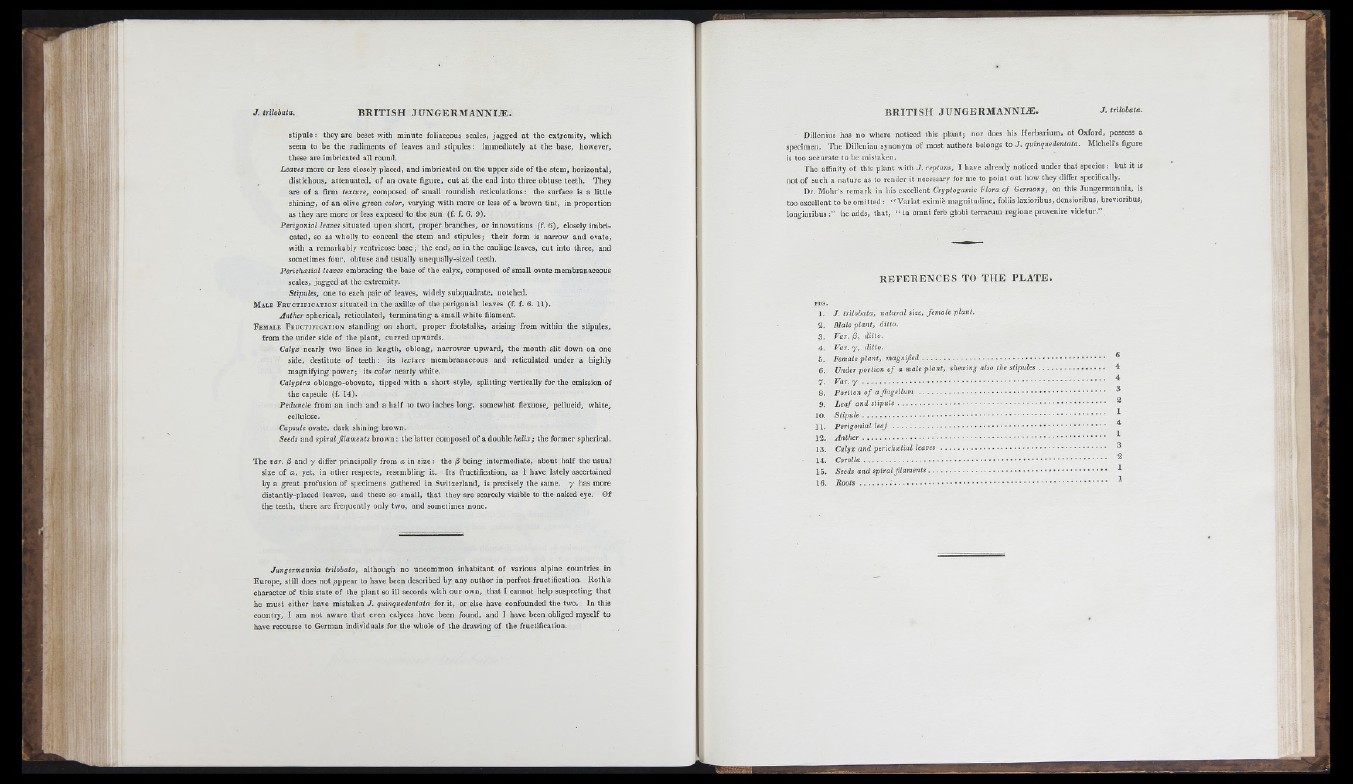
s tip u le : they a re beset with m in u te foliaceous scales, jag g ed a t th e extrem ity, which
seem to be th e rudiments o f leaves and stipules : immediately a t the base, however,
these a re imbricated all round.
Leaves more o r less closely placed, and imbricated on the uppe r side o f th e stem, horizontal,
distichous, attenuated, o f an ovate figure, cu t a t the end into thre e obtuse te e th . They
are o f a firm texture, composed o f small roundish reticulations: th e surface is a little
shining, o f a n olive green color, varjdng with more or less o f a brown tin t, in proportion
as they are more or less exposed to th e sun (f. f. 6. 9).
Perigomal leaves situated upon short, proper branches, o r innovations (f. 6) , closely imbricated,
so as wholly to conceal the stem and stipules; th e ir form is narrow and ovate,
with a remarkably ventricose ba se ; the end, as iu th e cauline leaves, cut into three, and
sometimes four, obtuse and usually unequally-sized teeth.
Pericheetial leaves embracing th e base o f th e calyx, composed o f small ovate m embranaceous
scales, jagged a t the extremity.
Stipules, one to each pair o f leaves, widely subquadrate, notched.
M al e F r u c t if ic a t io n s itu a te d in th e a x illæ o f th e p e rig o n ia l le a v e s (f. f . 6. 1 1 ) .
Anther spherical, reticula ted, te rm in a tin g a small white filament.
F em a l e F r u c t if ic a t io n s tan d in g on short, p rope r footstalks, arising from within th e stipules,
from the under side o f the p lan t, curved upwards.
Calyx nearly two lines in lengih, oblong, na rrowe r upwa rd, th e m onth slit down on one
side, de stitute o f te e th : its texture membranaceous and reticulated un d e r a highly
magnifying power; its color nearly white.
Cahjptra oblongo-obovate, tipped with a short style, sp litting vertically for the emission o f
th e capsule (f. 14).
Peduncle from an inch and a h a lf to two inches long, somewhat flexuose, pellucid, white,
cellulose.
Capsule ovate, dark shining brown.
Seeds and spiral filamenls brown ; the la tte r composed o f a double helix j the former spherical.
T he var. /3 and 7 differ principally from a in s iz e : the /3 being intermediate, about h a lf the usual
size of « , yet, in other respects, resembling it. Its fructification, as I have lately ascertained
by a g re a t profusion o f specimens gathered in Switzerland, is precisely th e same. 7 has more
distantly-placed leaves, and these so small, th a t they are scarcely visible to the naked eye. O f
the teeth, there are frequently only two, and sometimes none.
Jungermannia trilobata, a lthough no uncommon in h abitant o f various alpine countries in
Europe, still does n ot appe a r to have been described by any author in perfect fructification. R o th ’s
character of th is s ta te of the p lan t so ill accords with o u r own, th a t I cannot help suspecting th a t
he m u st eithe r have mistaken J . quinquedeniala for it, o r else have confounded th e two. In this
country, I am n ot aware th a t even calyces have been found, and I have been obliged myself to
have recourse to German individuals for the whole o f th e drawing o f th e fructification.
Dillenius has no where noticed this p la n t; nor does his H e rba rium , a t Oxford, possess a
specimen. T h e Dillenian synonym o f most authors belongs to J . quinquedentata. Micheli’s figure
is too a ccurate »0 be mistaken.
The affinity of this p lan t with J . reptans. I have already noticed under th a t species : b u t it is
not o f such a n a tu re as to render it necessary for me to point o u t how they differ specifically.
Dr. Mohr’s remark in his excellent Cryptogamic Flora o f Germany, on this Jun g e rm an n ia , is
too excellent to be om itte d : “ V a ria t eximife magnitudine , foliis laxioribus, densioribus, brevioribus,
longioribus he adds, th a t, “ in onmi ferb globi te rra rum regione provenire videtur.”
R E F E R E N C E S T O T H E P L A T E .
J . trilobata, natural size, fem a le plant.
Male p la n t, ditto.
Var. /3, ditto.
Var. 7 , ditlo.
Female p la n t, m a g nified ....................................................................................................... ®
Under portion o f a male plant, shewing also ihe s tip u le s ..................................... 4
V a r . y .........................................................................................................................................
Portion o f a fiageUum ......................................................................................................... ^
L e a f and s tip u le ..................................................................................................................... ^
S t ip u le ......................................................................................................................................... ^
Perigonial leaf ........................................................................................................................ ^
A n th e r ......................................................................................................................................... ^
Calyx and pericheetial leaves ............................................................................................. ^
C orolla......................................................................................................................................... ^
Seeds and spiral filam e n ls ..................................................................................................... ^
R o o t s ................. ^